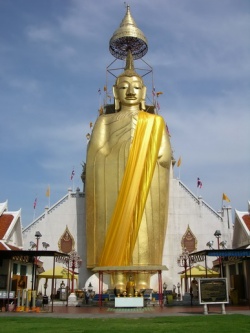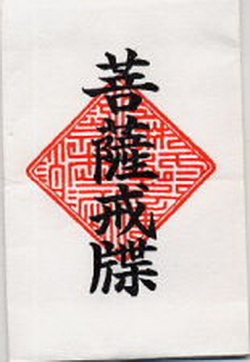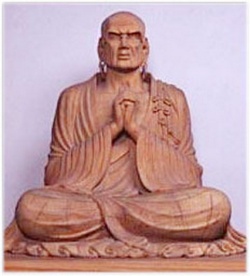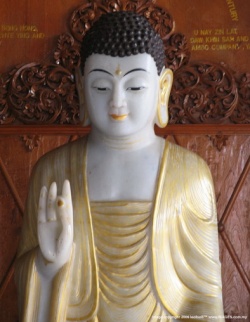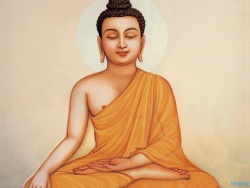Difference between revisions of "Buddhism in numbers"
(Created page with "thumb|250px| <poem> Rev. Jnana - Zen Dharma Teacher - IBMC A Dharma Talk at the IBMC --- The rather inelegant title of today’s talk, “Buddhism in the Nu...") |
|||
| Line 1: | Line 1: | ||
[[File:Lb23.jpg|thumb|250px|]] | [[File:Lb23.jpg|thumb|250px|]] | ||
<poem> | <poem> | ||
| − | Rev. Jnana - Zen Dharma Teacher - IBMC | + | Rev. [[Jnana]] - [[Zen]] [[Dharma]] [[Teacher]] - IBMC |
| − | A Dharma Talk at the IBMC --- The rather inelegant title of today’s talk, | + | A [[Dharma Talk]] at the IBMC --- The rather inelegant title of today’s talk, “[[Buddhism]] in the Numbers”, does an injustice to the elegance of the [[subject]] itself, the role of numbers in communicating the [[dharma]]. For there is indeed a rich vein of numerical references in [[Buddhism]], primarily in the [[sutras]], but also in related [[doctrines]] and teachings. My purpose here this morning is to briefly mine that vein, to bring a [[greater]] {{Wiki|degree}} of [[awareness]] to the place of numbers that permeate so much of our study and devotion along the [[Buddhist path]]. |
| − | First, a bit of historical and conceptual context. As we all know, Buddhism is in origin an Indian religion. As such it developed within an ancient cultural tradition whose scholarly mathematicians and astronomers were concerned with practical applications and who were motivated by a kind of passion for both numbers and numerical calculations. Indeed, India is the true birthplace of our numerals, which are popularly, but inaccurately, referred to as Arabic numerals. | + | First, a bit of historical and {{Wiki|conceptual}} context. As we all know, [[Buddhism]] is in origin an [[Indian]] [[religion]]. As such it developed within an {{Wiki|ancient}} {{Wiki|cultural}} [[tradition]] whose [[scholarly]] {{Wiki|mathematicians}} and astronomers were concerned with practical applications and who were motivated by a kind of [[passion]] for both numbers and numerical calculations. Indeed, [[India]] is the true birthplace of our numerals, which are popularly, but inaccurately, referred to as {{Wiki|Arabic}} numerals. |
| − | On a very basic, fundamental level, a practical application of the Indian passion for numbers was in the compilation of lists. For instance, if we set aside the accompanying stories and biographical/historical information in the Pali canon one is left with a whole pile of lists from the Buddha and long explanations about the lists. The Buddha was like a scientist observing reality and Ultimate Truth from the deepest levels of insight and enlightenment. The lists are the breakdown of the doctrines, concepts, and reality as communicated by the Buddha. | + | On a very basic, fundamental level, a practical application of the [[Indian]] [[passion]] for numbers was in the compilation of lists. For instance, if we set aside the accompanying stories and biographical/historical [[information]] in the [[Pali canon]] one is left with a whole pile of lists from the [[Buddha]] and long explanations about the lists. The [[Buddha]] was like a [[scientist]] observing [[reality]] and [[Ultimate Truth]] from the deepest levels of [[insight]] and [[enlightenment]]. The lists are the breakdown of the [[doctrines]], [[Wikipedia:concept|concepts]], and [[reality]] as communicated by the [[Buddha]]. |
[[File:Lide-00038.jpg|thumb|250px|]] | [[File:Lide-00038.jpg|thumb|250px|]] | ||
| − | Prior to the advent of written literature in India, including the initial written recording of the Buddhist sutras, knowledge was orally transmitted from one generation to the next. Once it was possible to record sacred texts in written form there was still reluctance on the part of religious figures to do so. The sacred word was deemed to be less sanctified if committed to writing. In a society in which it was quite possible for learned sages to commit the entire text of the Vedas to memory it is hardly surprising that the huge number of Buddhist lists, within the sutras, could be committed to memory by the various early Buddhist teachers and scholars. In a pre-literate society such lists were an ideal pedagogical approach as well as being very useful mnemonic devices. These enumerations helped, and still help, convey the meaning of the dharma. | + | Prior to the advent of written {{Wiki|literature}} in [[India]], including the initial written recording of the [[Buddhist sutras]], [[knowledge]] was orally transmitted from one generation to the next. Once it was possible to record [[sacred]] texts in written [[form]] there was still reluctance on the part of [[religious]] figures to do so. The [[sacred]] [[word]] was deemed to be less [[sanctified]] if committed to [[writing]]. In a {{Wiki|society}} in which it was quite possible for learned [[sages]] to commit the entire text of the [[Vedas]] to [[memory]] it is hardly surprising that the huge number of [[Buddhist]] lists, within the [[sutras]], could be committed to [[memory]] by the various early [[Buddhist]] [[teachers]] and [[scholars]]. In a pre-literate {{Wiki|society}} such lists were an {{Wiki|ideal}} pedagogical approach as well as being very useful mnemonic devices. These enumerations helped, and still help, convey the meaning of the [[dharma]]. |
| − | In succeeding centuries, when Zen developed in China, a rich tradition of writing already existed. Thus, the development of numbered lists greatly declined, as the original reasons behind them were no longer extant. Accordingly, in the examples that follow, there are relatively few Zen references. | + | In succeeding centuries, when [[Zen]] developed in [[China]], a rich [[tradition]] of [[writing]] already existed. Thus, the development of numbered lists greatly declined, as the original [[reasons]] behind them were no longer extant. Accordingly, in the examples that follow, there are relatively few [[Zen]] references. |
| − | In the Mahayana Lalitavistara Sutra the Sage Vishvamitra, who was teaching the eight-year old Shakyamuni, explained that numeration, numbers and arithmetic constitute the most important discipline among the seventy-arts and sciences that the Bodhisattva must acquire. At a later point in this sutra the Bodhisattva Shakyamuni, now of marriageable age, pits his wits against the great mathematician Arjuna. Shakyamuni displays a mind-boggling mastery of numbers and mathematical calculation, ranging from the measurement of the size of what we would call a molecule to a value equaling the number 1 followed by 421 zeroes. | + | In the [[Mahayana]] [[Lalitavistara]] [[Sutra]] the [[Sage]] Vishvamitra, who was [[teaching]] the eight-year old [[Shakyamuni]], explained that numeration, numbers and {{Wiki|arithmetic}} constitute the most important [[discipline]] among the seventy-arts and {{Wiki|sciences}} that the [[Bodhisattva]] must acquire. At a later point in this [[sutra]] the [[Bodhisattva]] [[Shakyamuni]], now of marriageable age, pits his wits against the great {{Wiki|mathematician}} {{Wiki|Arjuna}}. [[Shakyamuni]] displays a mind-boggling [[mastery]] of numbers and {{Wiki|mathematical}} calculation, ranging from the measurement of the size of what we would call a molecule to a value equaling the number 1 followed by 421 zeroes. |
[[File:Bangkok 0.JPG|thumb|250px|]] | [[File:Bangkok 0.JPG|thumb|250px|]] | ||
| − | On one level, it is difficult for a modern student of Buddhism not to be struck by the frequent use of very high numbers or large numerical descriptions (such “as many as dust motes in Buddha | + | On one level, it is difficult for a {{Wiki|modern}} student of [[Buddhism]] not to be struck by the frequent use of very high numbers or large numerical descriptions (such “as many as dust motes in [[Buddha lands]]”, references to [[kalpas]] and [[mahakalpas]], etc.) in certain [[sutras]] and historical accounts. This is a {{Wiki|reflection}} of the early [[passion]] that [[Indian]] {{Wiki|civilization}} exhibited for high numbers. While it is unclear if this particular [[passion]] had been developed at the [[time]] of the [[Buddha]], it certainly was in place at the [[time]] of the compilation of the later [[Mahayana sutras]] in the earliest centuries of the Common {{Wiki|Era}}. For instance, the previously mentioned [[Lalitavistara]] [[Sutra]] is replete with references to high numbers of [[gods]], [[divinities]], sons of [[gods]], [[Bodhisattvas]], [[Buddhas]], ornaments, [[flowers]], etc. The [[Lotus Sutra]] or numerous other [[Mahayana sutras]] would serve equally well as examples of the seeming {{Wiki|obsession}} in [[Indian]] [[Buddhist]] writings with high numbers. |
| − | When we chant om mane padme hum any reference to a numerical value is presumably far from our minds. The word padme, of course, means lotus. This flower is identified as the | + | When we [[chant]] om mane [[padme]] [[hum]] any reference to a numerical value is presumably far from our [[minds]]. The [[word]] [[padme]], of course, means [[lotus]]. This [[flower]] is identified as the ‘[[throne]]’ of the [[Buddha]] as well as of most of his [[manifestations]]. It also represents the [[bodhi]] or the [[Buddha nature]] of [[awakening]] to [[supreme enlightenment]]. It is this [[idea]] of [[absolute]] and [[divine]] [[perfection]] that gives the [[word]] [[padme]] a high numerical value as well. Originally [[padme]] represented the number ten to the ninth power. Over [[time]] this value increased to be identified with ten to the 119th power. A [[lotus]] of so many petals would be inconceivably large, as [[inconceivable]] as is [[supreme enlightenment]] itself to one who has not attained it. |
| − | Let’s turn from the rarefied realm of high numbers and proceed with what I’ll call “Jnana’s List”, which provides a very modest sampling of the more comprehensible enumerations of various aspects of devotional and descriptive attributes, qualities, concepts, and similar references that can be found in the Buddhist literature. My primary emphasis as we progress through only 20 of the most important numbers will be on the lower end of the scale, with the highest number considered being 108. The number 108 is an important magic and sacred number in Indian tradition, with one of its associations symbolizing perfection. In this context it refers to the 108 distinctive signs of perfection that distinguishes a Buddha from other human beings. Partly related to this usage then is the text of the chant, found at the back of our chant book, which we use in the | + | Let’s turn from the rarefied [[realm]] of high numbers and proceed with what I’ll call “Jnana’s List”, which provides a very modest sampling of the more comprehensible enumerations of various aspects of devotional and descriptive attributes, qualities, [[Wikipedia:concept|concepts]], and similar references that can be found in the [[Buddhist]] {{Wiki|literature}}. My [[primary]] emphasis as we progress through only 20 of the most important numbers will be on the lower end of the scale, with the [[highest]] number considered being [[108]]. The number [[108]] is an important [[magic]] and [[sacred]] number in [[Indian]] [[tradition]], with one of its associations [[symbolizing]] [[perfection]]. In this context it refers to the [[108]] {{Wiki|distinctive}} [[signs]] of [[perfection]] that distinguishes a [[Buddha]] from other [[human beings]]. Partly related to this usage then is the text of the [[chant]], found at the back of our [[chant]] [[book]], which we use in the “[[108]] Bows {{Wiki|Ceremony}}” on the first Sunday of each month. |
[[File:Blessingcards.jpg|thumb|250px|]] | [[File:Blessingcards.jpg|thumb|250px|]] | ||
| − | The first of the remaining 19 numbers to consider is 62. 62 refers to the “62 Kinds of Wrong | + | The first of the remaining 19 numbers to consider is 62. 62 refers to the “62 Kinds of [[Wrong View]]”. Here the [[wrong views]] are in reference to {{Wiki|eternity}}, [[self]] and [[causality]]. A [[characteristic]] example is the [[view]] that the [[self]] after [[death]] is healthy and [[conscious]] and {{Wiki|material}}. |
| − | 52 refers to the “52 Mental | + | 52 refers to the “52 [[Mental Formations]]”. These range from [[greed]] and [[hatred]] to discretion and [[balance]] of [[mind]]. |
| − | 40 refers to the “40 Meditation | + | 40 refers to the “40 [[Meditation]] [[Subjects]]”. This challenging list of [[subjects]] on which it is most fruitful to [[meditate]] includes a corpse that is hacked and scattered as well as the contemplation of [[charity]]. |
| − | 37 refers to the “37 Factors of | + | 37 refers to the “37 Factors of [[Enlightenment]]” or the “37 things that are conducive to [[awakening]]”. Among these factors are the [[four foundations of mindfulness]] as well as the [[Eightfold Path]]. |
| − | 32 refers to the “32 Parts of the | + | 32 refers to the “32 Parts of the [[Body]]”. These parts, ranging from teeth to {{Wiki|urine}}, are focal points for {{Wiki|reflection}} on their impure and [[impermanent]] {{Wiki|nature}}. |
| − | 32 also refers to the “32 Physical Marks” or the “32 Characteristics by Which a Great Man can be Recognized.” These marks are found on the body of both a Buddha and a Universal Ruler or chakravartin. Included among these are a long tongue, blue eyes, and webbed fingers and toes. | + | 32 also refers to the “32 [[Physical]] Marks” or the “32 {{Wiki|Characteristics}} by Which a Great Man can be [[Recognized]].” These marks are found on the [[body]] of both a [[Buddha]] and a [[Universal Ruler]] or [[chakravartin]]. Included among these are a long {{Wiki|tongue}}, blue [[eyes]], and webbed fingers and toes. |
| − | 31 refers to the “31 Planes of | + | 31 refers to the “31 Planes of [[Existence]]”. [[Ghosts]], [[animals]] and [[humans]] occupy three of the planes, for example, and [[devas]] of unbounded radiance occupy another. |
[[File:Bodhisattvaprecept.jpg|thumb|250px|]] | [[File:Bodhisattvaprecept.jpg|thumb|250px|]] | ||
| − | 22 refers to the “22 | + | 22 refers to the “22 [[Faculties]]”, as identified in the [[Abhidamma]]. Included here are the [[six senses]], the three factors concerning [[gender]], the five [[feelings]], the [[five spiritual faculties]], and the three super-mundane [[faculties]]. |
| − | 18 refers to the “18 Principal | + | 18 refers to the “18 Principal [[Insights]]”. A [[characteristic]] [[insight]] from this list is that “The contemplation of change abandons the [[perception]] of stability.” |
| − | 16 refers to the “16 | + | 16 refers to the “16 [[Arhants]]” and their [[disciples]], to whom the [[Buddha]] entrusted the care of his teachings at the [[time]] of his paranirvana. |
| − | We have two references to 12. The first is to the | + | We have two references to 12. The first is to the “[[12 Links]] of [[Dependent Origination]]” or [[pratitya-samutpada]]. When one link [[exists]] the link following arises as an effect or the preceding link, such as [[craving]] giving rise to [[grasping]] or [[birth]] giving rise to [[old age]] and [[death]]. |
| − | Another reference for 12 is the “12 Psychic | + | Another reference for 12 is the “12 [[Psychic]] [[Powers]]” possessed by a [[Buddha]], such as clairvoyance and recalling one’s previous [[existence]] and the [[existences]] of others. |
| − | The number 10 is probably one of the three most important numbers in Buddhist compilations, the other two being 3 and 5. We will begin with the | + | The number 10 is probably one of the three most important numbers in [[Buddhist]] compilations, the other two being 3 and 5. We will begin with the “[[10 Precepts]]”, the minimum number that each member of the {{Wiki|clergy}} sitting here on the tatami has taken in achieving their current position. |
[[File:Bodhisena.jpg|thumb|250px|]] | [[File:Bodhisena.jpg|thumb|250px|]] | ||
| − | 10 also refers to the | + | 10 also refers to the “[[10 Hindrances]] to [[Enlightenment]]”, otherwise known as the “[[10 Fetters]]”. Included among the [[fetters]] are [[conceit]], [[restlessness]] and [[ignorance]]. |
| − | Contrasting with the preceding listing, there are the “10 Good Deeds or Meritorious | + | Contrasting with the preceding listing, there are the “10 [[Good Deeds]] or [[Meritorious]] [[Actions]]”. Representative of these are non-greed, [[non-hatred]] and [[right views]]. |
| − | A set of powers ascribed to a Buddha differing from the “12 Psychic | + | A set of [[powers]] ascribed to a [[Buddha]] differing from the “12 [[Psychic]] [[Powers]]” mentioned earlier is described in the “10 [[Powers]] of a [[Buddha]]”. These [[powers]] confer on him [[knowledge]] of various aspects of [[existence]]. |
| − | The “10 Great | + | The “10 Great [[Disciples]]” refer to the [[Buddha’s]] most famous [[disciples]], including the first two [[Indian]] [[patriarchs]] of the [[Zen]] [[lineage]], [[Mahakasyapa]] and [[Ananda]]. |
| − | Finally, in the Zen tradition the “10 Oxherding Pictures” utilize an artistic metaphor for the path of meditation and the attainment of enlightenment. | + | Finally, in the [[Zen]] [[tradition]] the “10 Oxherding Pictures” utilize an artistic {{Wiki|metaphor}} for the [[path of meditation]] and the [[attainment]] of [[enlightenment]]. |
9 refers to the “9 Ways Not to Accept Something as Completely True”, such as “do not believe in something just because the authorities say it is so.” | 9 refers to the “9 Ways Not to Accept Something as Completely True”, such as “do not believe in something just because the authorities say it is so.” | ||
[[File:Buddha Jap.jpg|thumb|250px|]] | [[File:Buddha Jap.jpg|thumb|250px|]] | ||
| − | We are all familiar with the Noble Eight-Fold Path. 8 is additionally represented by the “8 | + | We are all familiar with the [[Noble]] Eight-Fold [[Path]]. 8 is additionally represented by the “8 [[Jhanas]]” or the 8 states of [[meditative]] absorption. |
| − | There are also the “8 Auspicious | + | There are also the “8 [[Auspicious]] [[Symbols]]”, [[signs]] of good [[fortune]] very popular in [[Tibetan Buddhism]] and linked with various aspects of [[Buddhist teachings]]. They are visually represented in the wall hanging on the [[south]] side of the tatami platform. |
| − | 7 refers to the | + | 7 refers to the “[[7 Factors of Enlightenment]]”, such as [[calm]] and [[equanimity]] as well as to the “7 [[Universal]] [[Mental]] Constituents”. These arise in every unit of [[consciousness]], such as [[feeling]] and [[perception]]. |
| − | 6 refers to the “6 Kinds of Temperaments”, which range from lustful to devout or faithful temperaments. | + | 6 refers to the “6 Kinds of Temperaments”, which range from [[lustful]] to devout or faithful temperaments. |
| − | Additionally, there are the “6 Paramitas or | + | Additionally, there are the “6 [[Paramitas]] or [[Perfections]]”: [[generosity]], [[morality]], [[patience]], [[effort]], [[meditation]] and [[insight]]. |
| − | 6 also refers to the “6 Realms of | + | 6 also refers to the “6 [[Realms]] of [[Rebirth]]”, ranging from [[gods]] to [[hell]] denizens. |
| − | All Buddhist laypersons have taken the “5 | + | All [[Buddhist]] laypersons have taken the “5 [[Precepts]]”. There are also the “5 [[Skandas]] or [[Aggregates]]”: [[form]], [[feeling]], [[sensation]], [[Wikipedia:Volition (psychology)|volition]] and [[consciousness]]. Finally, there are the “5 [[Moral]] [[Sins]]”: killing one’s mother or father, killing an [[arahant]], causing division in the [[sangha]] and wounding a [[Buddha]]. |
[[File:Buddha-115.jpg|thumb|250px|]] | [[File:Buddha-115.jpg|thumb|250px|]] | ||
| − | The | + | The “[[4 Noble Truths]]” are the foundation of all [[Buddhist teachings]]. 4 also refers to the “4 Supreme Efforts”, regarding [[unwholesome]] and [[wholesome]] [[thoughts]]. |
| − | There are “4 Types of People with | + | There are “4 Types of [[People]] with [[Realization]]”, beginning with the [[Stream Enterer]] and ending with the [[arahant]]. There are also “4 Types of [[Reincarnation]]”, through which one enters the cycle of [[rebirth]]. |
| − | Finally, the | + | Finally, the “[[4 Brahma Viharas]]” of [[loving-kindness]], [[compassion]], [[sympathetic joy]] and [[equanimity]] are key [[meditative]] practices. The positive qualities of each [[state of mind]] radiates outwards towards oneself, then to one’s family, the local {{Wiki|community}}, and eventually to all [[beings]] in the [[universe]]. |
| − | The number 3 strikes me as the most important of all in the various compilations, so I’ve included more references to it than any other number. Most all of us have taken the “3 | + | The number 3 strikes me as the most important of all in the various compilations, so I’ve included more references to it than any other number. Most all of us have taken the “3 [[Refuges]]” in the [[Buddha]], the [[Dharma]] and the [[Sangha]]. These are also collectively known as the [[Triple Gem]] or the [[Triratna]]. |
| − | 3 also refers to the triloka or the “3 | + | 3 also refers to the [[triloka]] or the “3 [[Worlds]]” or the “3 [[Realms]]” of [[existence]]. These are the [[Desire Realm]], the [[Form Realm]] and the [[Formless Realm]]. |
| − | All Buddhas manifest themselves in “3 | + | All [[Buddhas]] [[manifest]] themselves in “3 [[Bodies]]” or the [[Trikaya]]: the [[Truth Body]], the [[Body]] of [[Bliss]] and the [[Emanation Body]]. |
| − | There are “3 Roots of | + | There are “3 [[Roots]] of [[Evil]]”, namely [[greed]], [[hatred]] and [[delusion]]. All negative states of [[consciousness]] are ultimately grounded in one or more of these. |
| − | The “3 Characteristics of | + | The “3 {{Wiki|Characteristics}} of [[Existence]]” are [[suffering]] ([[dukkha]]), [[impermanence]] ([[anitya]]) and no [[permanent]] [[self]] ([[anatman]]). |
| − | Most of the above teachings are found within the | + | Most of the above teachings are found within the “[[3 Baskets]]”, or the [[Tripitaka]], of the [[traditional]] [[Buddhist canon]]. |
| − | Not to ignore Zen, there are the “3 Pillars of | + | Not to ignore [[Zen]], there are the “3 Pillars of [[Zen]]”: the constituent [[elements]] of [[teaching]], practice and [[enlightenment]]. |
| − | 2 represents our mundane understanding of reality, as reflected in our focus on duality. There are also the ”2 | + | 2 represents our [[mundane]] [[understanding]] of [[reality]], as reflected in our focus on [[duality]]. There are also the ”2 [[Truths]]”, [[relative truth]] and [[absolute truth]], the former referring to [[mundane]] [[reality]] and the latter to [[transcendental]] [[reality]]. |
| − | 1 refers to “1 | + | 1 refers to “1 [[Mind]]”, a focused, undisturbed [[mind]], {{Wiki|concentrating}} on a single [[object]]. 1 also refers to the one [[person]] whose [[birth]] into the [[world]] is for the {{Wiki|welfare}} of many {{Wiki|folk}}, a [[Tathagata]]. |
| − | Perhaps most important of all of these numbers is another manifestation of 1, namely each of you. Within each person in this room is a not yet fully realized Buddha nature, to which all of the other numbers mentioned here today ultimately point. | + | Perhaps most important of all of these numbers is another [[manifestation]] of 1, namely each of you. Within each [[person]] in this room is a not yet fully [[realized]] [[Buddha nature]], to which all of the other numbers mentioned here today ultimately point. |
</poem> | </poem> | ||
{{R}} | {{R}} | ||
[http://www.urbandharma.org/udharma7/numbers.html www.urbandharma.org] | [http://www.urbandharma.org/udharma7/numbers.html www.urbandharma.org] | ||
[[Category:108]] | [[Category:108]] | ||
Revision as of 11:48, 9 October 2013
Rev. Jnana - Zen Dharma Teacher - IBMC
A Dharma Talk at the IBMC --- The rather inelegant title of today’s talk, “Buddhism in the Numbers”, does an injustice to the elegance of the subject itself, the role of numbers in communicating the dharma. For there is indeed a rich vein of numerical references in Buddhism, primarily in the sutras, but also in related doctrines and teachings. My purpose here this morning is to briefly mine that vein, to bring a greater degree of awareness to the place of numbers that permeate so much of our study and devotion along the Buddhist path.
First, a bit of historical and conceptual context. As we all know, Buddhism is in origin an Indian religion. As such it developed within an ancient cultural tradition whose scholarly mathematicians and astronomers were concerned with practical applications and who were motivated by a kind of passion for both numbers and numerical calculations. Indeed, India is the true birthplace of our numerals, which are popularly, but inaccurately, referred to as Arabic numerals.
On a very basic, fundamental level, a practical application of the Indian passion for numbers was in the compilation of lists. For instance, if we set aside the accompanying stories and biographical/historical information in the Pali canon one is left with a whole pile of lists from the Buddha and long explanations about the lists. The Buddha was like a scientist observing reality and Ultimate Truth from the deepest levels of insight and enlightenment. The lists are the breakdown of the doctrines, concepts, and reality as communicated by the Buddha.
Prior to the advent of written literature in India, including the initial written recording of the Buddhist sutras, knowledge was orally transmitted from one generation to the next. Once it was possible to record sacred texts in written form there was still reluctance on the part of religious figures to do so. The sacred word was deemed to be less sanctified if committed to writing. In a society in which it was quite possible for learned sages to commit the entire text of the Vedas to memory it is hardly surprising that the huge number of Buddhist lists, within the sutras, could be committed to memory by the various early Buddhist teachers and scholars. In a pre-literate society such lists were an ideal pedagogical approach as well as being very useful mnemonic devices. These enumerations helped, and still help, convey the meaning of the dharma.
In succeeding centuries, when Zen developed in China, a rich tradition of writing already existed. Thus, the development of numbered lists greatly declined, as the original reasons behind them were no longer extant. Accordingly, in the examples that follow, there are relatively few Zen references.
In the Mahayana Lalitavistara Sutra the Sage Vishvamitra, who was teaching the eight-year old Shakyamuni, explained that numeration, numbers and arithmetic constitute the most important discipline among the seventy-arts and sciences that the Bodhisattva must acquire. At a later point in this sutra the Bodhisattva Shakyamuni, now of marriageable age, pits his wits against the great mathematician Arjuna. Shakyamuni displays a mind-boggling mastery of numbers and mathematical calculation, ranging from the measurement of the size of what we would call a molecule to a value equaling the number 1 followed by 421 zeroes.
On one level, it is difficult for a modern student of Buddhism not to be struck by the frequent use of very high numbers or large numerical descriptions (such “as many as dust motes in Buddha lands”, references to kalpas and mahakalpas, etc.) in certain sutras and historical accounts. This is a reflection of the early passion that Indian civilization exhibited for high numbers. While it is unclear if this particular passion had been developed at the time of the Buddha, it certainly was in place at the time of the compilation of the later Mahayana sutras in the earliest centuries of the Common Era. For instance, the previously mentioned Lalitavistara Sutra is replete with references to high numbers of gods, divinities, sons of gods, Bodhisattvas, Buddhas, ornaments, flowers, etc. The Lotus Sutra or numerous other Mahayana sutras would serve equally well as examples of the seeming obsession in Indian Buddhist writings with high numbers.
When we chant om mane padme hum any reference to a numerical value is presumably far from our minds. The word padme, of course, means lotus. This flower is identified as the ‘throne’ of the Buddha as well as of most of his manifestations. It also represents the bodhi or the Buddha nature of awakening to supreme enlightenment. It is this idea of absolute and divine perfection that gives the word padme a high numerical value as well. Originally padme represented the number ten to the ninth power. Over time this value increased to be identified with ten to the 119th power. A lotus of so many petals would be inconceivably large, as inconceivable as is supreme enlightenment itself to one who has not attained it.
Let’s turn from the rarefied realm of high numbers and proceed with what I’ll call “Jnana’s List”, which provides a very modest sampling of the more comprehensible enumerations of various aspects of devotional and descriptive attributes, qualities, concepts, and similar references that can be found in the Buddhist literature. My primary emphasis as we progress through only 20 of the most important numbers will be on the lower end of the scale, with the highest number considered being 108. The number 108 is an important magic and sacred number in Indian tradition, with one of its associations symbolizing perfection. In this context it refers to the 108 distinctive signs of perfection that distinguishes a Buddha from other human beings. Partly related to this usage then is the text of the chant, found at the back of our chant book, which we use in the “108 Bows Ceremony” on the first Sunday of each month.
The first of the remaining 19 numbers to consider is 62. 62 refers to the “62 Kinds of Wrong View”. Here the wrong views are in reference to eternity, self and causality. A characteristic example is the view that the self after death is healthy and conscious and material.
52 refers to the “52 Mental Formations”. These range from greed and hatred to discretion and balance of mind.
40 refers to the “40 Meditation Subjects”. This challenging list of subjects on which it is most fruitful to meditate includes a corpse that is hacked and scattered as well as the contemplation of charity.
37 refers to the “37 Factors of Enlightenment” or the “37 things that are conducive to awakening”. Among these factors are the four foundations of mindfulness as well as the Eightfold Path.
32 refers to the “32 Parts of the Body”. These parts, ranging from teeth to urine, are focal points for reflection on their impure and impermanent nature.
32 also refers to the “32 Physical Marks” or the “32 Characteristics by Which a Great Man can be Recognized.” These marks are found on the body of both a Buddha and a Universal Ruler or chakravartin. Included among these are a long tongue, blue eyes, and webbed fingers and toes.
31 refers to the “31 Planes of Existence”. Ghosts, animals and humans occupy three of the planes, for example, and devas of unbounded radiance occupy another.
22 refers to the “22 Faculties”, as identified in the Abhidamma. Included here are the six senses, the three factors concerning gender, the five feelings, the five spiritual faculties, and the three super-mundane faculties.
18 refers to the “18 Principal Insights”. A characteristic insight from this list is that “The contemplation of change abandons the perception of stability.”
16 refers to the “16 Arhants” and their disciples, to whom the Buddha entrusted the care of his teachings at the time of his paranirvana.
We have two references to 12. The first is to the “12 Links of Dependent Origination” or pratitya-samutpada. When one link exists the link following arises as an effect or the preceding link, such as craving giving rise to grasping or birth giving rise to old age and death.
Another reference for 12 is the “12 Psychic Powers” possessed by a Buddha, such as clairvoyance and recalling one’s previous existence and the existences of others.
The number 10 is probably one of the three most important numbers in Buddhist compilations, the other two being 3 and 5. We will begin with the “10 Precepts”, the minimum number that each member of the clergy sitting here on the tatami has taken in achieving their current position.
10 also refers to the “10 Hindrances to Enlightenment”, otherwise known as the “10 Fetters”. Included among the fetters are conceit, restlessness and ignorance.
Contrasting with the preceding listing, there are the “10 Good Deeds or Meritorious Actions”. Representative of these are non-greed, non-hatred and right views.
A set of powers ascribed to a Buddha differing from the “12 Psychic Powers” mentioned earlier is described in the “10 Powers of a Buddha”. These powers confer on him knowledge of various aspects of existence.
The “10 Great Disciples” refer to the Buddha’s most famous disciples, including the first two Indian patriarchs of the Zen lineage, Mahakasyapa and Ananda.
Finally, in the Zen tradition the “10 Oxherding Pictures” utilize an artistic metaphor for the path of meditation and the attainment of enlightenment.
9 refers to the “9 Ways Not to Accept Something as Completely True”, such as “do not believe in something just because the authorities say it is so.”
We are all familiar with the Noble Eight-Fold Path. 8 is additionally represented by the “8 Jhanas” or the 8 states of meditative absorption.
There are also the “8 Auspicious Symbols”, signs of good fortune very popular in Tibetan Buddhism and linked with various aspects of Buddhist teachings. They are visually represented in the wall hanging on the south side of the tatami platform.
7 refers to the “7 Factors of Enlightenment”, such as calm and equanimity as well as to the “7 Universal Mental Constituents”. These arise in every unit of consciousness, such as feeling and perception.
6 refers to the “6 Kinds of Temperaments”, which range from lustful to devout or faithful temperaments.
Additionally, there are the “6 Paramitas or Perfections”: generosity, morality, patience, effort, meditation and insight.
6 also refers to the “6 Realms of Rebirth”, ranging from gods to hell denizens.
All Buddhist laypersons have taken the “5 Precepts”. There are also the “5 Skandas or Aggregates”: form, feeling, sensation, volition and consciousness. Finally, there are the “5 Moral Sins”: killing one’s mother or father, killing an arahant, causing division in the sangha and wounding a Buddha.
The “4 Noble Truths” are the foundation of all Buddhist teachings. 4 also refers to the “4 Supreme Efforts”, regarding unwholesome and wholesome thoughts.
There are “4 Types of People with Realization”, beginning with the Stream Enterer and ending with the arahant. There are also “4 Types of Reincarnation”, through which one enters the cycle of rebirth.
Finally, the “4 Brahma Viharas” of loving-kindness, compassion, sympathetic joy and equanimity are key meditative practices. The positive qualities of each state of mind radiates outwards towards oneself, then to one’s family, the local community, and eventually to all beings in the universe.
The number 3 strikes me as the most important of all in the various compilations, so I’ve included more references to it than any other number. Most all of us have taken the “3 Refuges” in the Buddha, the Dharma and the Sangha. These are also collectively known as the Triple Gem or the Triratna.
3 also refers to the triloka or the “3 Worlds” or the “3 Realms” of existence. These are the Desire Realm, the Form Realm and the Formless Realm.
All Buddhas manifest themselves in “3 Bodies” or the Trikaya: the Truth Body, the Body of Bliss and the Emanation Body.
There are “3 Roots of Evil”, namely greed, hatred and delusion. All negative states of consciousness are ultimately grounded in one or more of these.
The “3 Characteristics of Existence” are suffering (dukkha), impermanence (anitya) and no permanent self (anatman).
Most of the above teachings are found within the “3 Baskets”, or the Tripitaka, of the traditional Buddhist canon.
Not to ignore Zen, there are the “3 Pillars of Zen”: the constituent elements of teaching, practice and enlightenment.
2 represents our mundane understanding of reality, as reflected in our focus on duality. There are also the ”2 Truths”, relative truth and absolute truth, the former referring to mundane reality and the latter to transcendental reality.
1 refers to “1 Mind”, a focused, undisturbed mind, concentrating on a single object. 1 also refers to the one person whose birth into the world is for the welfare of many folk, a Tathagata.
Perhaps most important of all of these numbers is another manifestation of 1, namely each of you. Within each person in this room is a not yet fully realized Buddha nature, to which all of the other numbers mentioned here today ultimately point.


